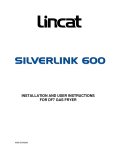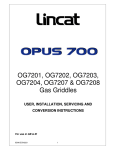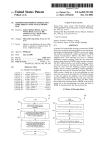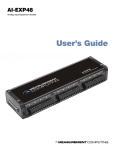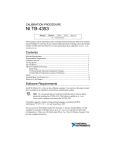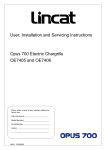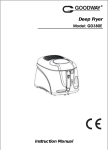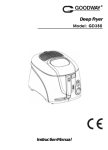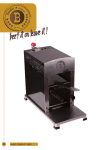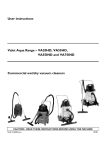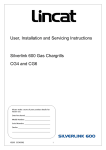Download installation and user instructions for j5 & j10 gas fryer
Transcript
INSTALLATION AND USER INSTRUCTIONS FOR J5 & J10 GAS FRYER IS 358 ECN 3258 INDEX • FOREWORD 3 • INSTALLATION INSTRUCTIONS 4-6 Ventilation. Installation position. Installation commissioning. Gas supply and connection. Appliance stability Pressure setting. Heat input. • NOTES ON FRYING 7-8 Frying media. Frying times. Frying tips. Oil capacity • OPERATING INSTRUCTIONS 9-10 Operating instructions. Preparation fo use Drainage and cleaning. • SERVICING 11-13 General servicing. Component replacement. • TROUBLESHOOTING. 14-15 • SPARES LIST 16 • TECHNICAL SPECIFICATION 16 • SERVICE 17 Contact information. Lincat service department. Conditions of guarantee. IS 358 ECN 3258 2 FOREWORD Thank you for buying this Lincat product, which we hope will give you years of trouble free service. To ensure you receive the maximum benefit from your new fryer please take the time to read this instruction book carefully, following any directions given. We manufacture over 300 different items of catering equipment and are constantly adding to and improving the range. If you’re thinking of extending your kitchen or renewing a catering appliance in the near future, see our sales brochures available from your local distributor or send for one direct from us before you make your decision. IMPORTANT Please read this page carefully before initially using the equipment. WARNING This appliance must be installed and serviced by a registered engineer. Whilst in operation, parts of the catering equipment will become hot. Suitable precautions must be taken to avoid accidental burns, therefore the appliance should be positioned to minimise the possibility of accidental touching. This appliance is for professional use and shall be operated by qualified personnel. CONSEQUENTIAL LOSS Lincat do not accept any responsibility for loss of food, production time, profit, etc., which may result from a break-down of the equipment MAINTENANCE 1) 2) These units must not be cleaned using a water jet. Clean units with water and detergent - do not use abrasives. IS 358 ECN 3258 3 INSTALLATION INSTRUCTIONS. Before commencing installation of the appliance please take time to read the following installation instructions carefully. Parts protected by the manufacturer are not to be adjusted by the installer or user. Unit : J5 & J10. All appliances should be installed in accordance with BS 6173:1982, Code of practice for installation of gas catering appliances, taking into account the Gas Safety Regulations 1984 as amended by the Gas Safety (Installation and Use)(Amendment) Regulations 1990 and the Health and Safety at Work Act 1974. It is mandatory that all appliances are installed and commissioned by a qualified and competent CORGI registered gas fitter. WARNING : Installation, service or repair of this appliance by non-CORGI registered personnel will invalidate its warranty. VENTILATION The area in which this equipment is to be installed should have sufficient fixed ventilation to comply with the requirements of Approved Document J in the 1985 Building Regulations. It is recommended that a minimum Area of 450mm2 per 1kWh (3400Btu/hr) of total heat input must be allowed. Particular attention should be paid to the low level ventilation to ensure that the appliance has a good supply of clean, fresh air. INSTALLATION POSITION. To ensure a free flow of air around and behind the appliance, clear space of at least 100mm must be left at the rear between flue and the wall and to either side of the appliance or bank of appliances. There should be a minimum clearance of 750mm between the top of the appliance and any overlying shelf or ceiling. Any partitions, walls or kitchen furniture in close proximity should be of non-combustible materials. INSTALLATION COMMISSIONING. To ensure a full understanding of the correct operation of the appliance the following commissioning checks must be carried out before the appliance is handed over for use. All operators must know how to light, safely operate and shutdown the appliance. Although all Lincat fryers are operationally checked during manufacture, commissioning shall include an operational check of all controls and a calibration check on the thermostat. This is carried out by filling the fryer to the correct level which is indicated on the batter plate, then setting the thermostat to 180 °C The oil temperature should be checked once the main burner has cut-out for the second time. If necessary calibration of the thermostat should be made as per the instructions found under the “Servicing” section. GAS SUPPLY & CONNECTION Check that the gas supply corresponds to that specified on the data plate. Connection is via a 1/2" bspt male thread on the back of the unit. If connection to the supply pipe is via a flexible hose, ensure that the hose used is suitable for commercial catering appliances. WARNING : Black domestic hoses are not suitable for this appliance. When making the connection on to the appliance, secure the hexagon on the fitting to prevent rotation of the internal pipework. An isolating cock should be fitted into the supply line to the unit for servicing purposes. IS 358 ECN 3258 4 INSTALLATION INSTRUCTIONS (Continued). Stabilising kit Installation instructions In accordance with BS EN 203-1 : 1993 sections 4.7.1 to 4.7.1.2 in terms of Stability where either a J5 or J10 is to be used as a free standing unit it must be suitably fixed to the floor with the bracketry provided. Recommended Fixing Procedure. 1. Site the fryer in its intended position, whilst complying with the instructions as detailed in the User Document. 2. Fit the upper brackets to the bottom of the unit using the screws provided. 3. Loosely fit the lower brackets to the upper brackets. 4. Mark the floor through the holes in the lower brackets. 5. Move the fryer to one side and drill the floor at the marking out points. A 7mm drill is recommended to accommodate the plugs provided. 6. Fit the plugs to the drilled holes. 7. Re-position the fryer so that the brackets align with the drilled holes. 8. Screw the lower brackets in place using the self tapping screws provided. 9. Level the fryer. 10. Tighten the adjusting screws. Parts list 2 x Upper brackets 2 x Lower brackets 8 x M5 x 20 Hex screws 4 x M5 Nuts 8 x M5 Flat washers 8 x M5 Shakeproof washers 4 x No12 x2” Slotted round head screws 4 x Fixing plugs IS 358 ECN 3258 5 INSTALLATION INSTRUCTIONS (Continued). PRESSURE SETTING Note: For model J10, set the pressure for each side independently. 1. Use the test point provided on the gas control valve marked “IN” (Fig 1, A), to check the supply inlet pressure. (Refer to technical data table on page 16). Note : An external regulator should be fitted to the fryer if the inlet pressure exceeds 50mbar 2. Use the test point marked “OUT” (Fig 1, B), to set the unit to the appropriate burner pressure. 3. Adjustment is made via the valve’s onboard governor, which is situated centrally on the valve. (Fig 1, C). 4. Remove the governor cap and turn the screw clockwise to increase the outlet pressure and anticlockwise to reduce it. 5. With main burner lit, (refer to operating instructions, page 9), adjust the burner pressure by the method described above to the value shown on the technical data table, page 16. 6. After setting, ensure the governor cap is properly secured and the blanking screws replaced in the test points. Fig 1. HEAT INPUT. The total nominal gross heat input for the appliances are as follows:- Models J5 and J10 Propane gas............. 11. / 22.04 kWh Natural gas.............. 11.5 / 22.79 kWh IS 358 ECN 3258 6 NOTES ON FRYING MEDIA Ensure oil is always maintained at the level indicated (H-high, L-low). Good quality vegetable oil is recommended. Animal fat may be used - but must always be melted first. Animal fat has a lower smoke and fire temperature than vegetable oil and taste is transferred when cooking with it (e.g. onions fried in animal fat will taint other foods i.e. fish which may follow). This does not occur when cooking with vegetable oil. The life expectancy of oils and cooking fats will be lengthened if they are filtered regularly - food particles not removed turn rancid and reduce oil/fat quality. Vegetable oils and animal fat are incompatible - e.g. if sausages containing a lot of animal fat are fried in vegetable oil, the oil will tend to "glue" and spoil. The life of oil or fat will also be extended if the temperature is turned down when the fryer is not in use otherwise if left "full-on" the oil is being subjected to needless heat treatment and thereby destroyed. Used oil symptoms firstly indicate discolouration by darkening. The oil becomes thin its fat content having become exhausted. The next symptom is an unhealthy yellow foam which may appear on the surface, and the third and more serious one is that the oil will boil or "surge" if not changed - thereby causing damage. Be safe, not sorry. Keep your oil in good condition and ensure a healthier food product and happier customers. Please note also, that "spent" oil will have a lower flash point than new oil and therefore present a greater fire hazard. Also avoid overflow from over-wet loads or over-large batches. In time, oil/fat may build up as a dried-on residue on tanks, baskets etc., although this can be minimised on baskets by regular washing in hot water and detergent. If, subsequently, it cannot be removed by normal cleaning, various branded cleansers are available such as "Carb ' n'off" which makes removal easy after overnight application. Carb ‘n’ off is available from us Part No. FCB01. If a fryer is to be out of use for a lengthy period, drain and clean the tank. Lightly oil tanks below the batter plate with cooking oil. Warning : Always allow oil to cool to a maximum 55 oC before draining. A GUIDE TO FRYING TIMES IS 358 ECN 3258 7 Food Type Fish Chips - blanching Chips - browning Chicken Fritters Scampi Mushrooms Frying Time 3-4 mins 3-4 mins 2-3 mins 9-12 mins 4-5 mins 4-5 mins 2-3 mins Temperature 170°C 160°C 190°C 160°C 180°C 180°C 180°C Frozen Foods When cooking frozen food, it is advisable to defrost the food before attempting to fry it. If frozen food is deposited into the oil, heating recovery times will be greatly reduced, lowering your cooking output. Defrosting will also ensure that surplus water is not placed into the oil. FRYING TIPS 1) pure 2) 3) 4) 5) 6) 7) 8) 9) Always use a good quality oil or fat, preferably oil which has a high breakdown temperature e.g. vegetable oil. Do not exceed the recommended cooking temperature stated by the supplier. Always maintain the oil at the correct level. Do not use the Fryer until the oil is at its correct temperature. Only use very clean oil and filter it daily. Whilst frying, carefully remove crumbs and pieces which float on the surface of the oil, otherwise this will carbonate and contaminate the oil. Keep the pan clean. Do not overload the baskets. Use batter plate/frying plate only if free frying of fish is required. OIL CAPACITY Model No. J5 J10 IS 358 ECN 3258 Capacity (litres) 14 14 per tank 8 OPERATING INSTRUCTIONS Note: Lids must not be used when cooking is in progress. Fig 2. a. b. c. d. e. f. g. Thermostat knob Control valve Pilot Limit reset location Drain valve blanking cap Drain valve lock Drain valve handle a e f c g d b LIGHTING of the APPLIANCE. Please ensure that the gas isolation valve for the appliance is turned to the open position before attempting to light this unit. 1. Ensure that the thermostat control knob (Fig 2, a) is in the OFF position. 2. Open the door and locate the control valve (Fig 2, c). 3. Ensure the pilot control knob is in the off position (Fig 3, 1). Push in and turn anti-clockwise to the Pilot position (Fig 3, 2). The knob will now depress further. 4. Keeping the pilot control knob depressed, press the piezo ignition button (Fig 3, 3). 5. Ensure the pilot is alight, a blue flame can be seen at (Fig 2, c). Hold the pilot control knob in for 20 seconds to establish the pilot flame. 6. When the pilot is lit, release the pilot control knob and turn fully anti-clockwise to the ‘Main Burner’ position (Fig 3, 4). 7. If the pilot flame fails to remain lit, return the pilot control knob to the off position and repeat the process allowing a short period of time for the control to reset. 8. To operate the main burner, turn the thermostat control knob (Fig 2, a) to the required temperature setting. Fig 3 STANDBY IS 358 ECN 3258 9 Once the pilot is lit the appliance may be left on standby by leaving the pilot control knob in the pilot ignition position. (Fig 3, 2). When in this position the appliance cannot be operated from the thermostat control knob. To re ignite the main burners turn the pilot control knob anti-clockwise to the burner position, (Fig 3, 4), and operate the control thermostat as normal. Note: Should the safety cut-out thermostat operate during normal use the unit will shut down. To relight the unit allow the oil to cooled to a temperature below 200oC. Re-set the safety thermostat by depressing the red re-set button. (see fig 2) SHUT DOWN of the APPLIANCE. 1) When the appliance is not required, turn the thermostat fully anti-clockwise which will shut down the main burner but leave the pilot lit ready for when the appliance is next required. 2) To turn the unit off completely, turn the thermostat fully anti-clockwise and the pilot knob fully clockwise. PREPARATION FOR USE 1) 2) 3) 4) 5) Ensure that the drain valve is closed. Fill the tank with water and a little mild detergent. Turn the unit "ON" (see Operating Instructions) and allow the water to boil for a short time. Switch off and drain off the water. Rinse the tank and dry thoroughly. Ensure that the drain pipe and tap are dried thoroughly. Run a small quantity of oil across the base of the tank and allow to drain to waste. This will remove any residual water and provide the base of the tank with a coating of oil. Close the drain valve DRAINAGE 1) Always allow the oil to cool to a maximum 55 oC before draining. 2) Remove the blanking nut, (Fig 2, e), from the front of the unit. Fit the pipe supplied and place a suitable receptacle under the pipe outlet. Lift the drain valve handle lock, (Fig 2, f), to allow operation of the drain valve. 3) Move the drain valve handle, (Fig 2, g), forward and upward to drain. Close the valve, remove the pipe and replace the blanking nut. Ensure that the drain valve handle lock has dropped into position before refilling the tank. 4) Take care when draining the oil that the drain bucket is not filled so full that it is difficult to handle. 5) Excess oil remaining in the base of the tank can be mopped up using kitchen paper CLEANING INSTRUCTIONS Note: Clean the appliance with hot water and a mild detergent do not use abrasives. In extreme conditions a branded cleanser such as “Carb ‘n’ off ” makes cleaning easier after an overnight application. 1) 2) 3) 4) 5) Isolate the appliance from the gas supply. Allow the oil to cool to a maximum 55 oC. Drain as per above instructions. Wash the tank and the top surface of the fryer body. Clean the drain tube assembly, using a tube or flue brush suitable for 15mm tube, with the drain valve in the open position. Clean by inserting the brush into both the inlet and outlet of the drain. 6) Wash all parts thoroughly. 7) Ensure all parts are thoroughly rinsed and dried. To ensure there is no water left in the drain tube, flush thoroughly with a small amount of clean cooking oil. 8) Re-assemble by reversing the above procedure. IS 358 ECN 3258 10 SERVICING Gas catering equipment should be routinely serviced to ensure a long trouble-free life. With this in mind it is recommended that the appliances are serviced every 6 months by a competent gas engineer. Please see page 17 “Service” for information on authorised service agents. (J5 & J10 General service). 1. • • • Carry out a general check of the installation paying particular attention to the following:has the unit been installed using the correct hose? does the unit have a safety chain? does the equipment have a separate isolation valve? 2. Check all components for correct operation and replace where necessary, following the appropriate instructions. 3. Visually check the burner operation, closely observing the flame picture and look for evidence of any debris or damage. Remove burner and clean or replace as necessary. 4. Visually check the injectors and replace or clean as necessary (Clean using a brush with nylon bristles or similar). Avoid using metal reamers or wire as this may damage or increase the orifice size. 5. Check the burner pressure and adjust where necessary with the unit in full operation, at the test nipple located on the burner. See “Installation Instructions”- “Pressure Setting” for information. 6. Check operation of the limit thermostat. 7. Clean pilot assembly and check that it is burning cleanly. 8. Check the alignment of the spark electrode and thermocouple within the pilot assembly. Adjust if necessary. 9. Ensure that the flue is clear. 10. Carry out a gas soundness check. 11 J5/J10 Component Replacement. Ignitor Electrode and Pilot Jet 1. Undo pilot gas feed pipe, the pilot jet will come away when the pipe is removed. 2. Undo two screws attaching pilot mounting bracket to front of burner chassis and drop pilot assembly clear of chassis. 3. Disconnect igniter lead from bottom of igniter. 4. Remove igniter electrode, held to bracket by a single screw. 5. Reversal of above for reassembly. Ensure pilot jet is refitted when fitting pilot pipe. Thermocouple. (This operation is easier if the pilot assembly is removed, see above). 1. Undo the brass nut on top of the bracket which secures the thermocouple to the pilot bracket and pull down. 2. Undo the nut holding the thermocouple into the rear of the valve. 3. Disconnect the wires from the interrupter terminal block 4. Replace the thermocouple 5. Reversal of the above for re assembly. Thermopile. 1. Disconnect the thermopile lead at the control valve. 2. Loosen the thermopile retaining nut located underneath the pilot assembly. 3. Withdraw the thermopile from the pilot bracket. 4. Reversal of above for reassembly. Control Thermostat. 1. Drain fryer 2. Remove the Thermostat control knob and the control panel facia. 3. Disconnect the wires from the thermostat and remove the screws holding the thermostat to the facia. 4. Remove the small gland assembly nut where the capillary enters the tank. 5. Free the thermostat phial from thermostat clip inside tank. 6. Reversal of the above for re assembly. 12 Gas Control Valve. 1. Disconnect the thermocouple, thermopile and thermostat connections. 2. Remove the piezo igniter button assembly, held by a single screw on front of valve. 3. Disconnect the pilot pipe, gas supply pipework and the burner pipework 4. See previous notes for thermostat replacement and thermocouple replacement. 5. Remove four screws securing the valve to chassis. 6. Remove brass fittings from old valve and fit these to the replacement valve. N.B. Replacement valves are not supplied with the brass fittings. 7. Reversal of the above for re assembly. 8. For propane units remove the governor cap, unscrew the adjuster and remove with the spring. 9. Replace with Lincat part number SP65 and reassemble. 10.Reset burner pressure as per “Installation instructions”, “Pressure setting”. Safety Thermostat. 1. Drain oil from fryer tank. 2. Remove the thermostat housing and locate the thermostat. 3. Remove the brass nut holding the thermostat to the housing. 4. Disconnect the wires from the thermostat. 5. Undo the gland nut at the front of the tank. 6. Unclip the thermostat phial from the bracket inside the tank. 7. Pull the thermostat phial through tank. N.B. there will be some resistance due to the packing behind the gland nut having become compacted. 8. Reversal of above for re assembly. Burner. 1. Remove access panel at rear of appliance. 2. Disconnect supply pipe from rear of burner at the inlet elbow. 3. Unscrew the inlet elbow and remove. (The burner jet is located in the elbow). 4. On Natural gas units remove the inlet baffle plate held by a single screw to the centre of the bracket. 5. At the front of the appliance, locate the burner fixing screw under the chassis and remove. 6. The burner can now be removed through the rear access opening. 7. Reversal of above for re assembly. 13 FAULT FINDING Explanation of the Control System The gas circuit in this fryer is operated by two separate millivolt systems. The first consists of an interrupted thermocouple, the pilot burner(s) and the gas control. Heat from the pilot flame acting on the thermocouple generates a 15-30 mV electrical potential. This millivolt system connected to the gas control operates the first solenoid that allows gas to the pilot burner. The over temperature stat is included in this system which operates via the interrupted thermocouple. The first solenoid operates as the safety device which shuts down in the event of a thermocouple failure or if the over temperature stat goes open circuit. The secondary millivolt system consists of a thermopile acting through the gas control via the control thermostat. Heat from the pilot flame acting on the thermopile generates a 500-700 mV electrical potential. This millivolt system connected to the gas control operates the secondary solenoid that passes gas to the main burners. The system is interrupted by the control thermostat as it cycles, thereby opening and closing the gas supply to the main burners. The following trouble shooting flow charts are designed to give assistance on the most probable cause of failure of the gas circuit. Use the step by step instructions to quickly pinpoint problems and the advice to help in taking the appropriate action to rectify them. Piezo Igniter not sparking. Is there a short in the High Tension Lead. No Has Electrode Insulator Fractured. Yes. Yes. No. Replace Electrode. If no spark is generated at all, replace Piezo Ignitor. Replace Lead. 14 FAULT FINDING (cont’) Pilot burner will not light or stay lit. Are the thermocouple/Interrupter connections secure. Yes. No Is there gas at the pilot when holding control knob in the pilot position. Yes. Tighten connection. No. Very little. Check overtemperature stat for open circuit. Check supply. Check thermocouple voltage (minium 15mV). Check pilot jet for blockage and clean where necessary. Check supply. If all of the above are OK the control valve may be faulty. High limit thermostat operates. Is the oil temperature over 220oC. Yes. No Does the control stat operate on temp. rise when set point is low (100oC). Replace overtemperature stat. No. Yes. Are the connections correct on the gas control. Yes. Replace overtemperature stat. Replace control stat. No. Correct connections. Manually reset overtemp stat. 15 SPARES LIST. The following components are listed with the Lincat reference number followed by a brief description. IG14...................................................... Ignitor Electrode. IG19………………………………….. Piezo Igniter. PI25...................................................... Pilot assembly. TC19.................................................... Thermocouple. TC20…………………………………. Thermopile. TH99………………………………. Control Thermostat. TH96.................................................... Safety Limit Thermostat VA20.................................................... Gas Control Valve Technical Data. (Models J5 and J10). Dimensions J5 H1060 x W300 x D700 J10 H1060 x W600 x D700 J5 34.8kg / J10 69.5kg 1/2 BSP Weight Inlet connection Heat Input (Gross). Supply Pressure Burner Pressure Injector size Gas Rate Heat Input (Gross). Supply Pressure Burner Pressure Injector size Gas Rate Natural Gas (G20). 11.5 kWh / 22.79 kWh 20 mbar 16.3 mbar 1.90 mm 1.05 m3 h-1 / 2.35 m3 h-1 Propane Gas (G31). 11.0 kWh / 22.05 kWh 37/50 mbar 25 mbar 1.35 mm 0.79 kg h-1 / 1.58 kg h-1 16 SERVICE Gas catering equipment should be routinely serviced to ensure a long trouble free life. With this in mind it is recommended that the appliances are serviced every 6 months by a competent gas engineer. For help regarding the installation, maintenance and use of your LINCAT equipment, please call:- LINCAT GROUP SERVICE HELP DESK 01522 500881 AUTHORISED SERVICE AGENTS We recommend that all servicing other than routine cleaning be carried out by our authorised service agents and will accept no responsibility for work carried out by other persons. Note that for safe and efficient operation, appliances need regular servicing. Please quote both the model and serial numbers from the data plate attached to the unit. Give brief details of the service requirement. If you know the part number of the part in question, please quote this information also. Lincat reserve the right to carry out any work under warranty during normal working hours, i.e. Monday to Friday, 8.30 a.m. - 5.30 p.m. CONDITIONS OF GUARANTEE The guarantee does not cover:1) 2) 3) Accidental breakage or damage Operational misuse, wear and tear from normal usage, incorrect adjustment, or neglect. Incorrect installation, maintenance, modification or unauthorised service work. 17

















